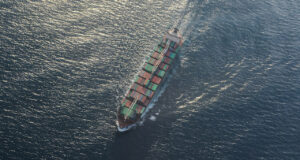How are supply chain issues affecting manufacturers who serve the hydro industry? What are companies doing to confront supply chain shortages, transportation delays, and price increases? To get a manufacturer’s perspective, Hydro Leader spoke with Paul Meeks, the president and founder of Worthington Products.
Hydro Leader: Please introduce yourself and your company.
Paul Meeks: I founded Worthington Products in 2000 to provide waterway barriers to hydroelectric power producers and dam owners. Our products help dam owners lower their risk and potential liability from public safety incidents by providing highly visible upstream and downstream barriers to prevent entry into dangerous zones. For hydropower producers, our barriers systems help increase power generation output by preventing the head losses associated with the blockage of intakes by debris and ice. I started doing this around 1996 as a manufacturer’s representative. When one of the companies I represented went out of business, I decided that it was time to form a company solely focused on waterway barriers. I never imagined then that we would grow to become the world’s best-known barrier manufacturer, with products in 64 countries.
Hydro Leader: Where do you source your materials, and where do you manufacture your products?
Paul Meeks: Our production and manufacturing partnerships are spread globally. The United States and Canada account for the bulk of production. Over the past 10 years, however, we have formed production partnerships in Brazil, France, India, Poland, Portugal, and Turkey.
Hydro Leader: When did you start to see supply chain disruptions, and what form did they initially take?
Paul Meeks: Red flags occurred early in the first quarter of 2021. We knew there were port problems, but their effects were not felt on our business until late January 2021. That is when we saw problems start. Originally, it was a logistics issue, but by the start of the second quarter, we knew we were entering a new paradigm. Port backlogs, COVID‑19 shutdowns, trucker shortages, and even the norms for container transshipments created the perfect storm. What had been a typical $6,300 charge for a 40‑foot high-cube container from port of loading to port of clearance jumped overnight and quickly became $23,000. This was made worse by container shortages and even ship shortages. Getting a booking with a container line became a daily struggle. It was nearly impossible. In addition to higher transportation rates, we were introduced to something I’ve never seen in the ocean freight industry in my more than 26 years of experience. Freight brokers were now demanding booking surcharges as high as $5,000 to get a confirmed spot in line. That got you on the ship, sometimes, but it did not help with the congestion at the port of entry. This cascaded domestically, affecting the availability of containers to load for export, a problem that persists today. This year, we have had to schedule containers 2 months in advance for exports abroad. Before the COVID‑19 pandemic, we would have scheduled a container 4 days prior to shipment. I’ve never experienced challenges like this. You hear talk about how we need to produce more in the United States, and I could not agree more, but the reality of the matter is that the global economy is intertwined. We lost significant manufacturing capacity in this country long ago, and there are some materials that are simply not produced domestically or for which we lack expertise.

To respond to this, Worthington held weekly supply chain meetings beginning in early 2021. We were proactive in communicating with our customer and supplier base to set expectations. We aggressively identified critical-path items and implemented plans to prevent a single critical-path item delay from affecting our promises to clients. We originally expected this to be a one-time, short-term blip caused by the emergence of COVID‑19. We were wrong. The global supply chain finished 2021 in worse shape than it had been in at the start. All manufacturers were being hit on multiple fronts. The cascading effects of the crisis are visible in the prices and surcharges we pay, in limited quote validity, and in lead times.
The year 2022 ushered in regular increases in the prices of raw materials and finished parts. It is not uncommon to receive an updated material quote with a caveat stating, “This is not the price you will pay. We will charge the market rate on the day the product ships.” That adds uncertainty when bidding a project that is 12 months out. We do not have an office full of economists who can develop models predicting pricing 12 months from now. I suppose if there is any silver lining in this, it is the fact that all manufacturers are in the same boat. It’s how you manage these challenges that sets you apart. Worthington has been aggressive in tackling these market uncertainties early on and developing solutions to avoid disruptions to our business.
Hydro Leader: What does the term critical-path items refer to, and what are examples of those items?
Paul Meeks: For every project, we identify all the components and services that are required to bring the project to completion. We then assign a risk category—green, yellow, or red—to determine which items have the ability to make a good project into a bad project. Red-category items and services are those that may require greater lead times or carry higher risk or are subject to factors outside our ability to influence. This category receives immediate and ongoing attention from project management and senior-level management. We develop strategies to move the red-category items into the yellow or green zones. Typically, that comes down to allowing extra time by ordering early. Occasionally, that may require using alternate vendors and locations. But unforeseen challenges remain. For example, when the Ever Given container ship blocked the Suez Canal last year, we had 18 containers on several ships behind the Ever Given. In that case, all we could do was hope they got the ship dislodged and then moved the backlog through the canal as fast as possible. Beyond that, we were entirely transparent with our clients about what was taking place and how we were mitigating the challenge.
Hydro Leader: Have you also had issues with material availability?
Paul Meeks: The availability of materials, especially steel and resin, is an ongoing concern. For companies that outsource production, the worst thing they can do right now is get in an argument with companies in their supply chain. They risk having that supplier walk away. Before the COVID‑19 pandemic, manufacturers had subsuppliers knocking down their doors for new business. Right now, suppliers are at capacity because of new business, limited labor, or cutbacks caused by reduced margins. Many are reluctant to take on new business if it is not profitable. That’s just the reality. Suppliers have more leverage than ever before, and they are not afraid to wield that newfound power.
This new reality has caused us to evaluate our supply chain model. If one link in the supply chain breaks, that puts us at risk. We are transitioning away from a supply chain model toward a supply net model. By identifying and qualifying additional supply partners, we are able to expand our supply net so that no single break in the net can harm our business.
Communication is key. We communicate early and frequently with our customers to avoid surprises. This is especially true for projects in cold-weather environments for which there is only a limited window to deliver and install the booms. I constantly reinforce the importance of communication with our team members. I tell them that if at the onset, we told the client to expect delivery on June 15, and they are standing on the loading dock looking for the big yellow Worthington truck to arrive and it does not show up, shame on us. We dropped the ball. Our customer’s trust in our word is shattered. We must let our clients know as early as possible of any actual or potential delays and, this is the important part, inform them about the steps we are taking to prevent those disruptions. Communication through the entire supply chain is crucial.
Hydro Leader: Has part of your response also been to build up extra supplies of certain items?
Paul Meeks: Not only have we increased quantities on hand, but we’ve increased the time material sits on our lot. Anyone running a small business knows that this is a recipe for cash flow challenges. Incoming inventory is cash going out the door. Eventually, this balances out, but we are acutely cognizant of the effects on cash flow. Having strong lines of credit and bankers who understand your business are important to having the flexibility to stock up.
Hydro Leader: It seems that the first round of supply chain issues was closely connected to the pandemic. Have there been further issues related to the war in Ukraine or international sanctions on Russia?
Paul Meeks: We are only a few months into Russia’s aggression against Ukraine, so the effects have been muted. Petroleum prices spiked, and that created challenges. Obviously, it increased transportation costs, but it also affects plastic resin, foam, and other raw materials. In this country, we have vast energy reserves. We can tackle the petroleum pricing effect. What we lack, however, is the political resolve to support our domestic energy industry, at least until there are viable alternatives. As the aggression against Ukraine continues, however, the effects will be felt, especially on the steel and raw materials sectors.
Hydro Leader: Do you plan to make any changes to your operations over the long term?
Paul Meeks: Our shift from a supply chain model to a supply net model will continue and will become a permanent feature of how we operate. We still source some components from China. In early 2020, we set a strategic imperative to get out of China. Does that mean bringing production back to our shores? Where possible, yes. But there are some items that America simply lacks the capacity, ability, or economy to produce, so we apply a global approach that also fits into our migration to a supply net model.
I believe the future is bright for those who see these not as roadblocks but rather as challenges to overcome and to grow from. There is a quote by Joshua Marine that states, “Challenges are what makes life interesting, and overcoming them is what makes life meaningful.” We truly believe this, and that is what makes every day at Worthington so exciting.
Paul Meeks is the president and founder of Worthington Products. He can be reached at pmeeks@tuffboom.com or (330) 452‑7400.


